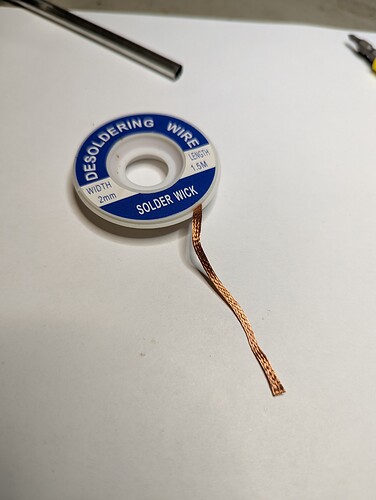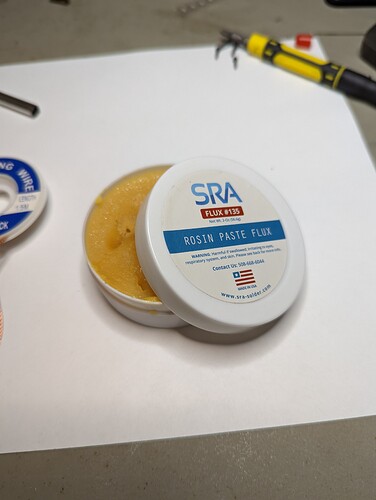Well then, never mind. It’s been up on the wall for so long I didn’t realize.
This is a question and not a statement. I wonder if the original antenna is defective on SOME hubs (or batches of hubs)? Or maybe there is a bad connection/solder joint that gets fixed when you are doing this modification?
There seem to be a handful of people who have continuous issues, while others seem to have no issues. I haven't ever had what I considered Zwave problems despite my hubs (both a C5 and a C7) being in the basement and adjacent to the furnace and heating ducts and main support beam for the floor.
I would be interested to see if someone could actually check or diagnose the original antenna. I always like to find the root cause of the problem whenever possible. I can't argue with the results here, but I can question the "why".
But aren't there are so many situational differences that can also explain why some people have no issues? e.g,. metal vs. plastic boxes, framing details, interference from other devices, etc.
I believe I know the why, at least for our home. We have a lot of brick, tile, and mirrors on the walls. Device control worked fine with Wink, but, well, that company started to crash and burn, and I couldn’t do complex things. Then, SmartThings, device control worked fine, but that platform started its crash and burn. Then went with Hubitat, device control wasn’t great, but I could do great automation, locally, so I became determined to make it work, and bought a bunch (8) repeaters and sprinkled them around. For the most part, that fixed things, but I still see a continual churning of the routing.
Wink, SmartThings, and Hubitat hubs were/are centrally located in the same place.
So, now I’m trying the Heidrick Antenna mod, and it’s looking very good. I’m convinced that the underlying why is the brick, tile, mirrors construction. I just want to make everything work solidly, and I’m willing to try anything to get to a good “how”.
The joints on all three hubs that I have modified were fine.
Mine solder joints C5 were done perfectly. The C7 is next.
With the C5 in the basement I could not pair a motion sensor in the addition about 65 feet away. After the antenna mod, it paired up right away. I made several attempts before/after the mod to be sure.
@csteele
I'm convinced that the key to this mod and its (great) improvement is
NOT IN: the Hub reaching the device
but rather
IN: the device (all the devices) reaching the Hub directly without any repeating.
When there is no repeating, signals are received much faster.
Isn't that also behind the promise of Zwave LR - that all devices will communicate directly with the Hub?
Absolutely agree. I also went for a lower gain antenna, as I wouldn't want the transmitting unit to hit a sensor 200 feet away, that the tiny sensor couldn't reach back to the hub, due to the sensor's limited transmit power, although I 'suspect" the SDK has built in logic to prevent that???
Has anyone seen any change in their Zigbee network performance using an external antenna? It seems like most folks who are reporting improvements, are focused on Z-Wave. Just curious if there have been any Zigbee success stories.
I do agree that the benefit is most likely to be in the RX side of the equation and not the TX side.
And it's ideal to bring this difference up now, given that all the other pieces of the puzzle have been discussed. 
The transmitters on our various devices are packed so tightly that their antenna are folded and possibly even 1/8 wave. Thus the challenge is getting the Hub to even receive the device's signal. I know I've mentioned that the Hub's antenna need only be as good as the 'first ring' of repeaters because beyond that, it's the repeater's TX and RX that drive the stability. Adding this external antenna, and possibly its rotated radiation pattern has improved reception to the point that Direct is functional for more devices.
I didn't find anything that indicated the TX side is better with the external antenna, beyond the orientation of the radiation pattern... and who knows how many of us don't have the antenna pointing up/down  I'm left with the idea that the RX is improved... only because that's what's left over after TX is eliminated.
I'm left with the idea that the RX is improved... only because that's what's left over after TX is eliminated. 
I would expect the the higher gain antenna would also have higher sensitivity for receiving, and so connectivity to distant devices should balance out? You'd get more of the problem you describe if we were (somehow) increasing the actual transmitter power. That's my guess anyway, someone more knowledgeable on the topic doubtless knows more!
Back when I had easy access to an RF engineer it seems like it took at least a week to get the esoteric terms and concepts passed from their brain to mine. "Ground plane?" What? "caged dipole" What? 
Such a large amount of time has elapsed between then and now that I remember quadratic equations better than RF theory. 
My focus at the time was related to specifying my needs related to microstrip on a PCB and thus most of my questions and resulting knowledge is a mile off for THIS topic 
Yes, An aerial with gain improves both transmit and receive performance. An inbalance in transmit power causes one sided reception. One contradiction is that weaker distant nodes can form direct to hub paths that might perform better via a repeater. Direct is obviously fast but connections are limited in number. I believe a lot of issues in Z-Wave, especially 700 series are mesh management. i.e. links via repeaters.
Caveat : I am not an RF Mesh network fan… Z-Wave or ZigBee ![]() Matter is promising though. But ‘needs must’ in some situations usually because of retrofit.
Matter is promising though. But ‘needs must’ in some situations usually because of retrofit.
I’ve been following this thread since it started. While I have mostly Zigbee devices, I don’t know that I would be able to tell any difference on the Zigbee side because it is so fast already, although some devices that seem to like being a child of the hub (Hue dimmers) might be able to go back on the HE. My Z-wave on the other hand is so slow, even dimmers a couple feet away, not to mention a hop away, surely couldn’t be worse. I just have to work up the courage to operate on the hub, unless an antenna version comes out soon.
I think I owe a final update for my External Antenna journey...
I have a total of 31 ZWave devices on one hub, with zero Zigbee. When I powered up the hub after the mod I saw 25 devices with DIRECT. A couple days later, 26. It's now 7 more days after the mod and I have 30 showing as DIRECT with the anecdotal info that the one hold out was DIRECT a couple days ago.
I've been severely messing with this hub in that time. I had lazily added non-S2 devices using Hubitat and that yields a S0 join. 30 devices and who cares if there's a couple dozen extra packets an hour?? But this past week I've moved those S0 devices to 'S-None'. I have 3 Barrier devices and they are all S0, as required. One S2 device because I want at least one.  This hub covers less than a third of the devices in my home.
This hub covers less than a third of the devices in my home.
I did a ZWave repair on this one device and Zniffer shows it's talking DIRECT but nothing in the UI has updated yet.
For me, I like the result. I can detect no difference in responsiveness or stability. I had a good working hub before, I have one after. I like that it's all direct, I like that there's mostly 100k connections and I like that it motivated me to remove S0 where possible. 
Edit: The Hub UI came round and is now indicating I have 100% DIRECT. I'd paste the Mesh Details screen cap as proof, but when there are no hops, that table is not displayed. 
Well I'll say that out of all the hubs I've modified (quite a few at this point) I haven't seen any bad solder joints at all. Some hubs were the newest revision and some were the first rev without the reinforced usb-c connector and they all looked very good.
I think the biggest benefit comes from more devices not having to route through other devices. The less devices having to route through other devices the better everything works. More responsive and don't have all kinds of weird routes going from one side of the house then over to the other side then back again. Each hop probably adding in latency and possibly dropping the speed. Not to mention the bandwidth restrictions that come with meshing all over the place and the load on the mesh that creates.
The right tool makes all the difference. The most difficult part is unsoldering the existing antenna. Solder wick didn't work, a solder sucker didn't work, but this cheapo sucker/iron can desolder almost anything. Because if you don't remove enough existing solder the U.FL connector won't sit flat for a solid connection to the board. The tool below is good for about 25 uses ,before the plastic handle snaps from all the force of the spring, but well worth the price
I use a little spool of copper wick and dip it in some flux paste and it works like a charm. Then just trim it off after each time I soak up some solder. Best to take your time on this part and use enough heat to get it to get it to soak up quick. I run my iron at 750. Cleaning and tinning your tip before using the wick will help with the heat transfer.
Think of it like a cell tower and devices being phones. The tower power is far higher than the phones power. With better antennas the tower can transmit and receive or listen better. Cell towers use directional antennas that help focus their directional capabilities even further than an Omni.
There is no question in my mind after going through this thread:
The number 1 enhancement in the next model of Hubitat has got to be an external antenna (Zwave + Zigbee)
What a simple enhancement, and what a great gain!
I hope that the powers that decide things like that are listening!



